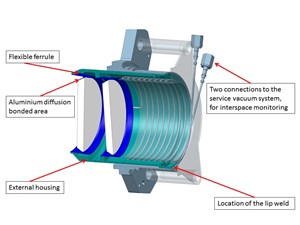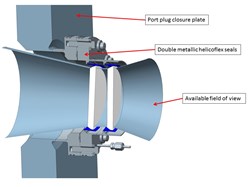ITER NEWSLINE
-
A protected view of the plasma for ITER diagnostics
Michael Keane, Diagnostics Division
A protected view of the plasma for ITER diagnostics

A window assembly with two disks made of fused silica: the external housing of the window assembly (in green) is inserted into a window tube and welded to it by means of a lip weld, which makes the junction leak tight. Aluminium diffusion bonding can be used to bond the window materials to the flexible metallic ferrule.
Development is underway on vacuum windows that will allow ITER diagnostics to extract light from the plasma in a safe way.
Most of ITER's diagnostics will have optical, microwave or spectroscopic viewing lines in order to monitor the plasma characteristics and make physical measurements inside of the vacuum vessel. For many of them, the nature of the physical signal transmitted dictates the design and makeup of the windows assemblies, which incorporate material such as glass or ceramics.
Work is ongoing to determine the best material combinations and manufacturing procedures for these ITER diagnostic window assemblies. The work benefits from experience gained on other tokamaks such as JET, TFTR and JT60. Considering the additional challenges of the ITER operating environment, there is a continuing requirement for innovative solutions—at all times with an eye to ensuring conformance to nuclear safety requirements. The design, manufacture and assembly of the vacuum windows are not explicitly covered by nuclear construction codes; consequently, the Diagnostic Division has worked with experts in the field and produced a code of practice to ensure that the assemblies meet the nuclear installation requirements.
One of the key requirements for these window assemblies is the transmission of optical, microwave or spectroscopic signals from the plasma to the diagnostic without attenuation or disturbances. Several types of materials will be incorporated, all chosen to fit the specific wavelength used by the diagnostic equipment (typically from 200 nm up to several mm).

Integration of a bolted window assembly on the port plug closure plate. Both the window interspace and the metallic seal interspace are monitored for leak tightness.
A second requirement is ensuring the vacuum integrity required for the plasma. The window assemblies—including window and seal—must remain leak tight to the very last day of ITER operation. With this in mind, a robust double window disc arrangement will be incorporated (see images), creating an interspace that will be monitored to detect a leak on either side.
There have been many design challenges to overcome during the development process. This includes the choice of materials for the windows themselves (materials under investigation include fused silica, sapphire, SF06G05 Shott glass, synthetic quartz, CVD diamond and barium fluoride) and the challenge of incorporating the windows into the machine environment.
Tantalum has been widely used in the past as an interface material (also known as a ferrule, this is a ring that surrounds the window to facilitate the attachment of the window to its surrounds). But in ITER, tantalum is not suitable: "Neutrons activate the tantalum and make it a dominant radiation source," explains Alejandro Suarez, one of the engineers in the Diagnostics Division. "As a result, other materials have been successfully developed."
Experience gained on other tokamaks has shown that aluminium diffusion bonding can be used to bond the window materials to a flexible metallic ferrule. Technical developments are still necessary to address specific issues. R&D is underway at the Culham Centre for Fusion Energy, UK (Special Techniques Group) and, in addition, the Diagnostics team at ITER is working on an ongoing basis with Bertin Technologies (France). Collaboration with companies like these is an integral part of the success of this project.
"The preliminary design for each type of window assembly is ongoing," says Philippe Maquet, from Bertin Technologies, "and a particular effort is being made to standardize the diagnostic window assemblies in order to manage the cost and reduce interfaces."
The next milestone of the window assemblies roadmap is the Preliminary Design Review, planned for the end of 2015. The first batch of window assemblies shall be shipped to the ITER site in early 2018.
return to the latest published articles








